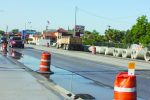District academic ratings slip
By LPR Staff
Editor/POST-REGISTER
According to the latest accountability ratings released by the Texas education Agency (TEA), students in the Lockhart Independent School District are making the grade. Although the ratings show room for improvement in several areas, the students overall are performing at or above the level deemed “acceptable” by the state on t
he Texas Assessment of Knowledge and Skills (TAKS) standardized test.
The TAKS test is designed to test several different areas of education, with a focus on key concepts that students should learn at each grade level. Results of the test are used in a variety of ways, including making determinations about students” advancement through the grades. State and federal laws dictate how the test should be administered, at which grade levels and how schools are expected to perform.
Performance scores are broken into four levels, Academically Unacceptable, Academically Acceptable, Recognized and Exemplary. This year, all of LISD”s schools earned “Acceptable” ratings, except for Lockhart High.
Assistant Superintendent of Curriculum James Rabe said the results show promise, regardless of the fact that two LISD campuses earned lower ratings this year than last.
Lockhart Junior High achieved a “Recognized” status last year, meaning that more than 70 percent of the students passed all areas of the TAKS test. This year, the campus missed “Recognized” status by a hair”s breadth.
“In the eighth grade, 28 of the students failed the math portion of the test by [three questions or less,” he said. “Those 28 students passing would have been more than enough to move the junior high”s rating from “acceptable” to “recognized.””
Rabe added that the situation was similar at several grade levels in most areas of the TAKS test, and he said he feels encouraged.
“We can find out what areas of the test are giving the students problems, and redouble our efforts in those areas,” Rabe said. “There are enough students who are just missing those one or two or three questions that when we get them, we”re going to be knocking on the door of “Recognized” for the whole district.”
Rabe committed to continuing his research on the test results to pinpoint the problems and help the teachers focus on the areas where students seem to be having the most difficulty.
“It”s not going to be an overnight process,” he said. “It might take a year or two, but I”m sure we can get there.”
A slight change in testing procedures caused some havoc in TAKS testing and accountability ratings at the high school level.
For the first time this year, special education students were included in grade-level testing.
According to Rabe, state standards allow for testing of special education students in line with their Individual Education Plans (IEPs). In some cases, this group of students functions at a lower grade-level than their assigned grade level would require. For instance, a special education student classified as a sophomore might only read at a seventh-grade level.
In the past, these students were given State Developed Alternative Assessment (SDAA) tests according to their level of functionality, rather than their level of classification.
This year, in compliance with federal “No Child Left Behind” standards, SDAA tests were required to be tested at grade level. Committees consisting of administrators, special education teachers and diagnosticians chose the testing level to be administered to 95 percent of the special education students.
“It was the first time high school has administered the test and they weren”t sure what to do to make the numbers work,” Rabe said.
Under the state guidelines that dictate the TAKS test, lower percentages of students have to pass the tests to earn the school an “Acceptable” rating. Federal standards require that at least half of the students taking the SDAA pass, or the school will be rated “Unacceptable.”
Rabe said several districts experienced the same problem with the SDAA tests. Indeed, in this area, Bastrop High and Anderson High School were assigned “Unacceptable” ratings based solely upon SDAA scoring.
If the school earns an “Unacceptable” rating again next year, the district could be subject to sanctions from the state, up to and perhaps including a requirement to give students options of other districts to attend. However, Rabe is confident that a second “Unacceptable” rating will not be an issue.
“This doesn”t affect the status of the regular education students, so far as scholarships, top ten percent and the like is concerned,” he said. He continued that there is something of a “learning curve” for administrators where standardized tests are concerned, and that the SDAA situation will not happen again.
“We”re working with the teachers and the students and next year, we”ll be able to handle the testing a lot better.”



